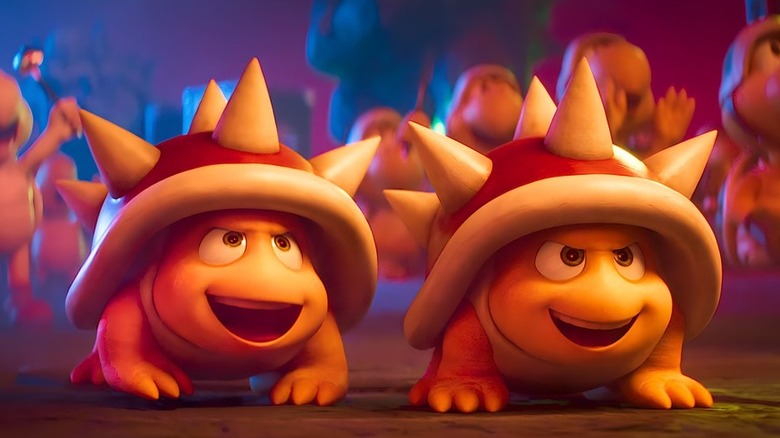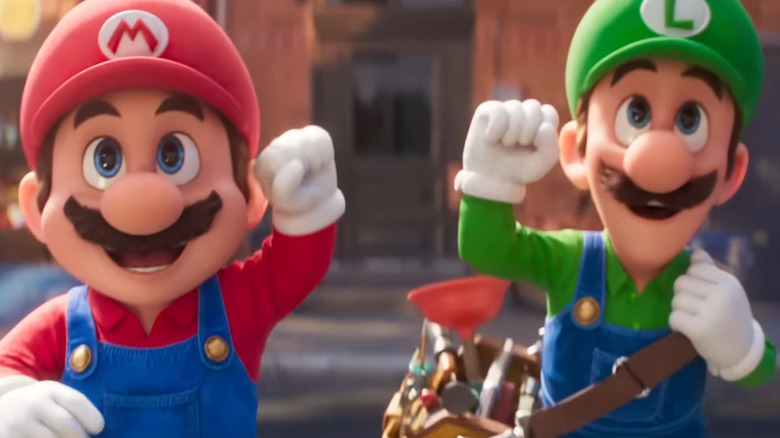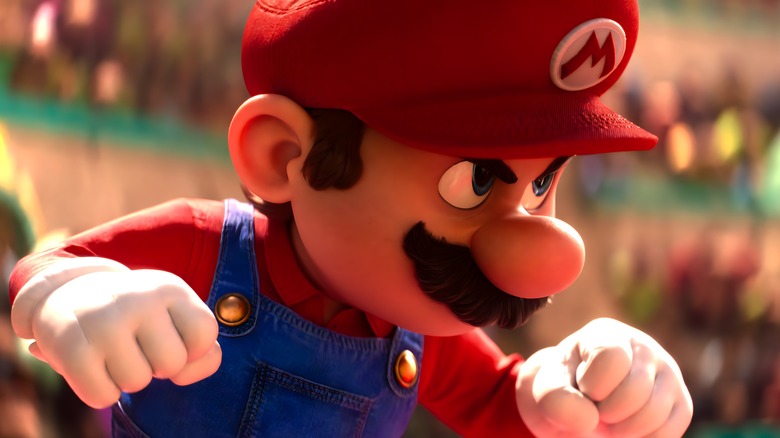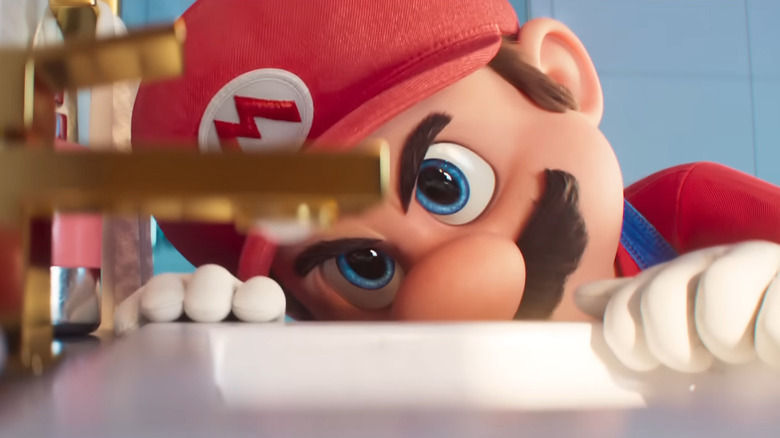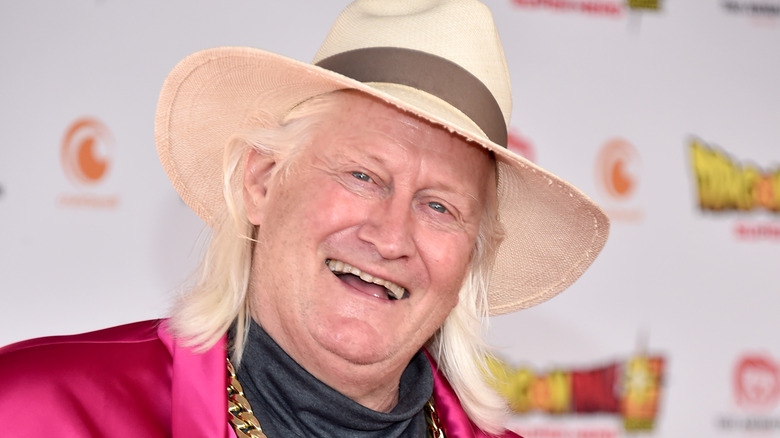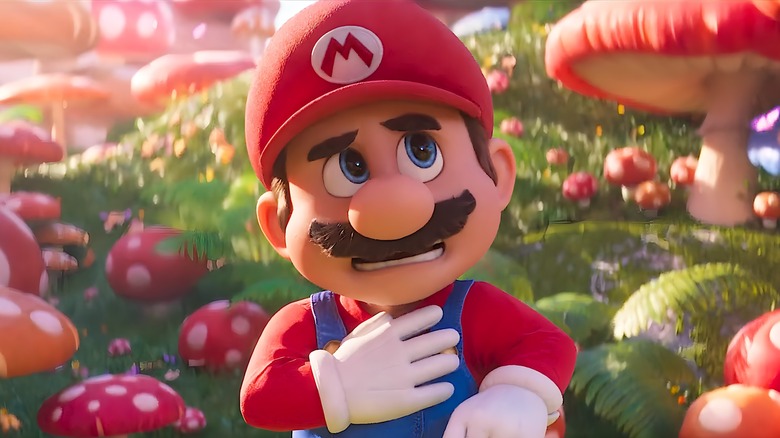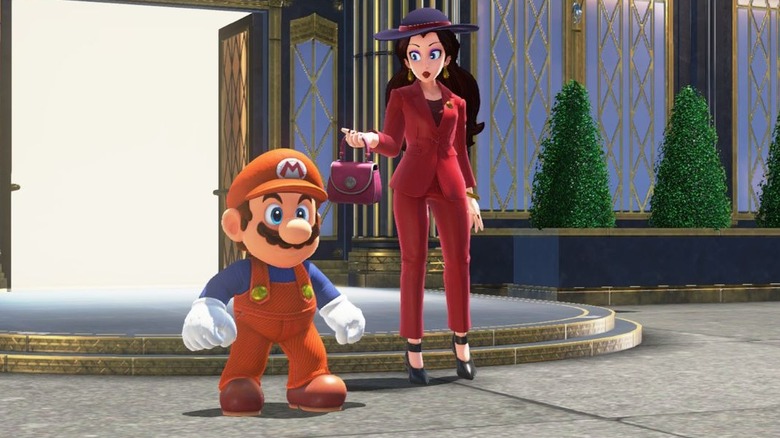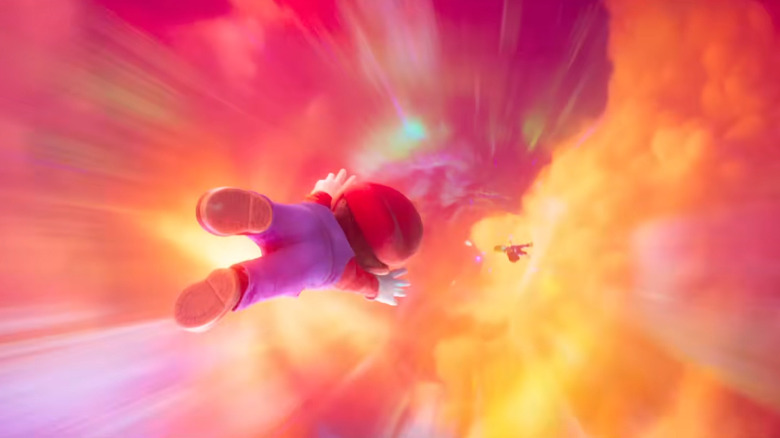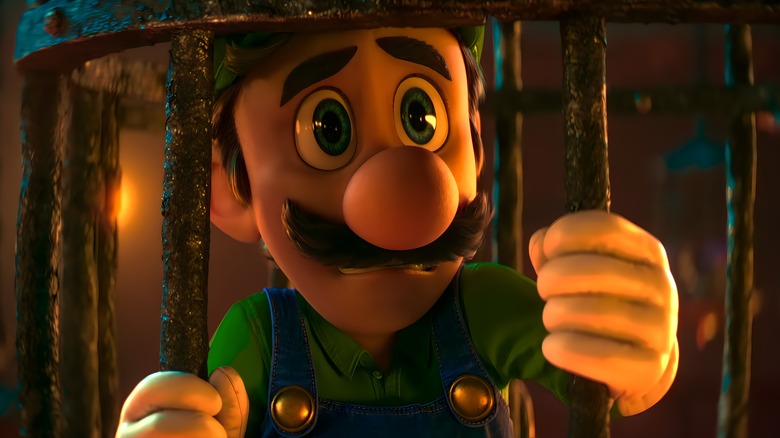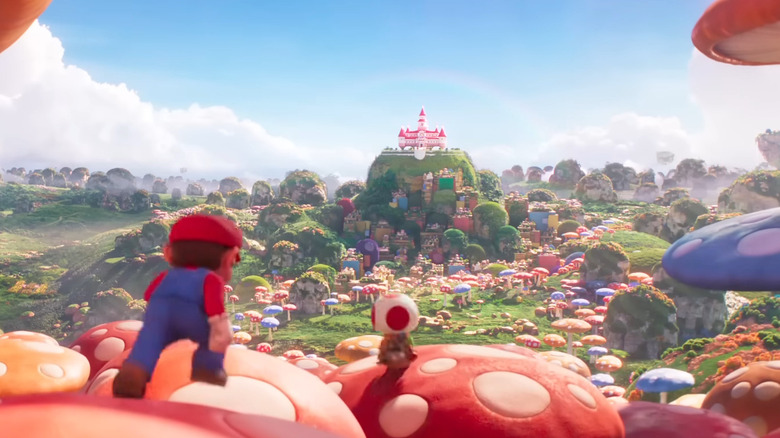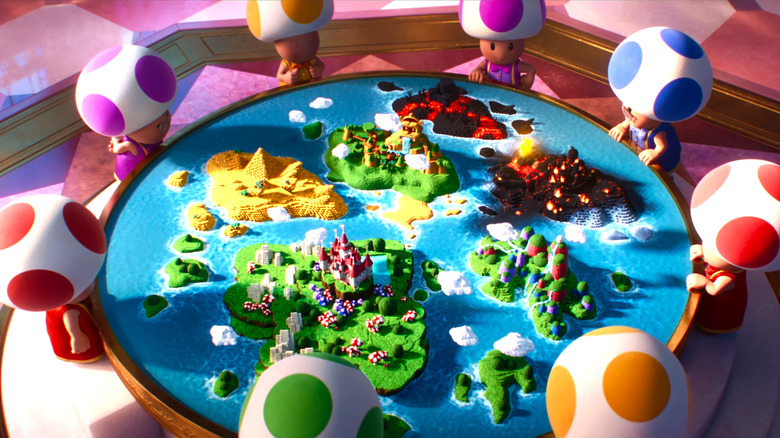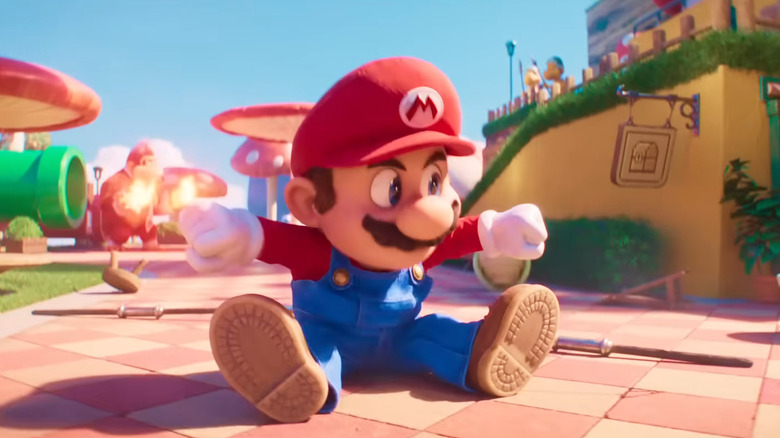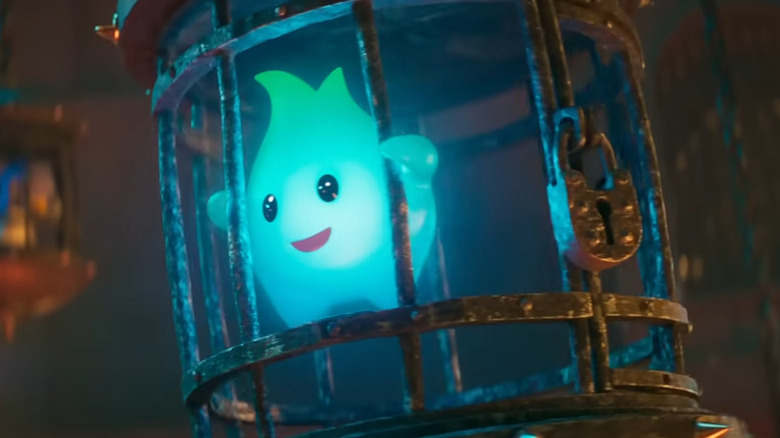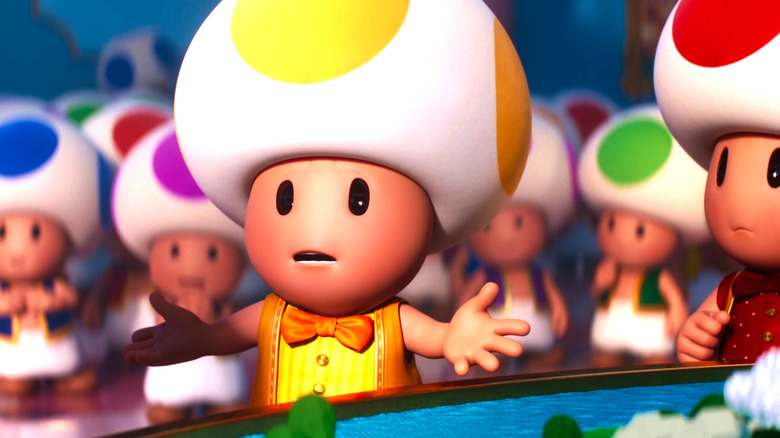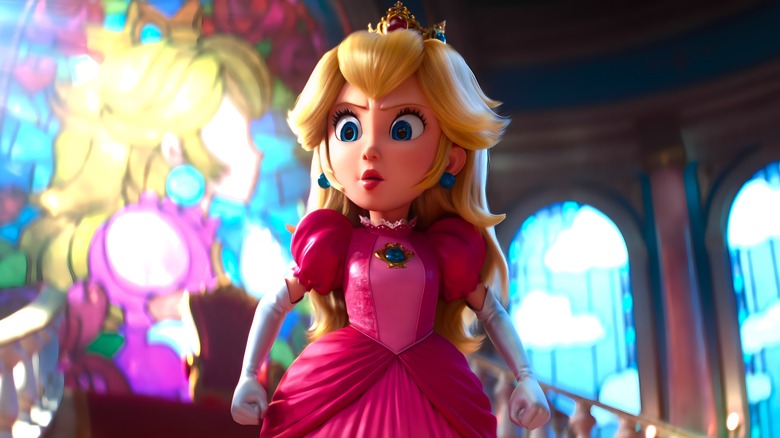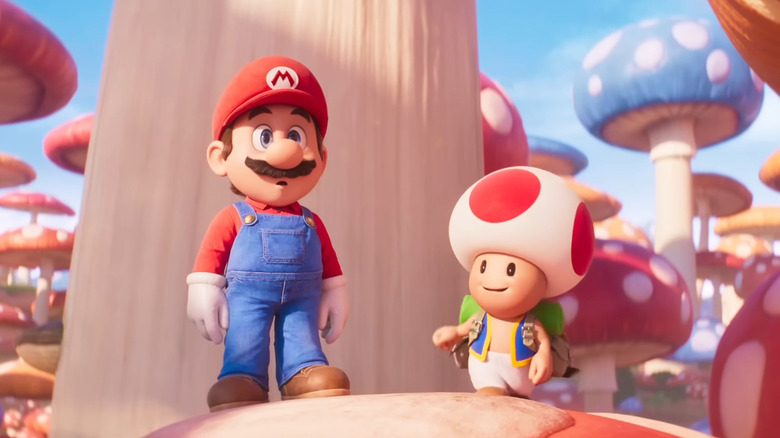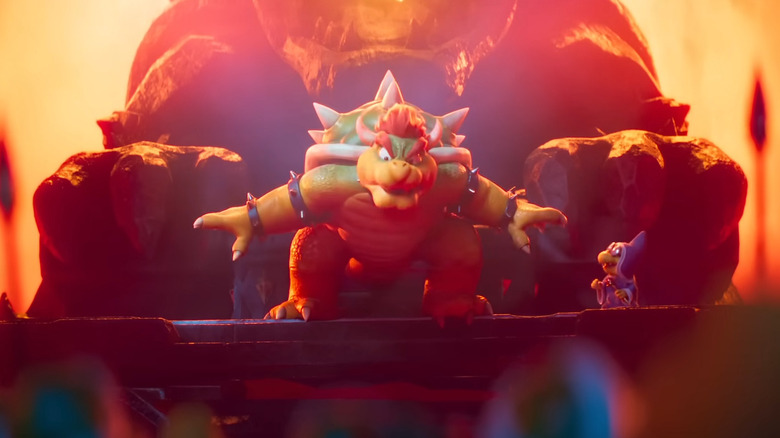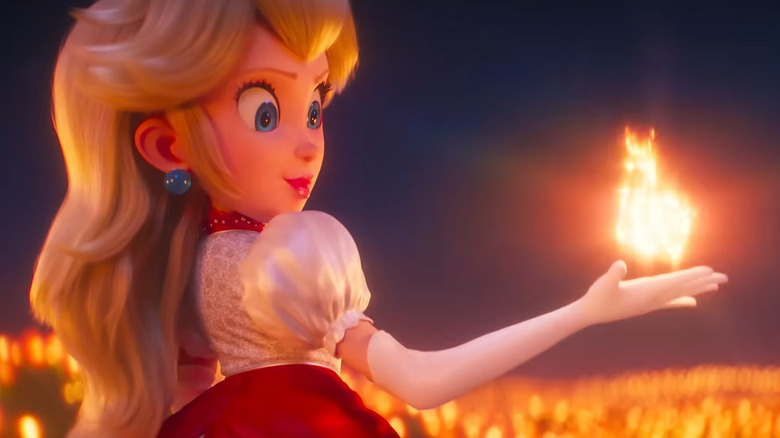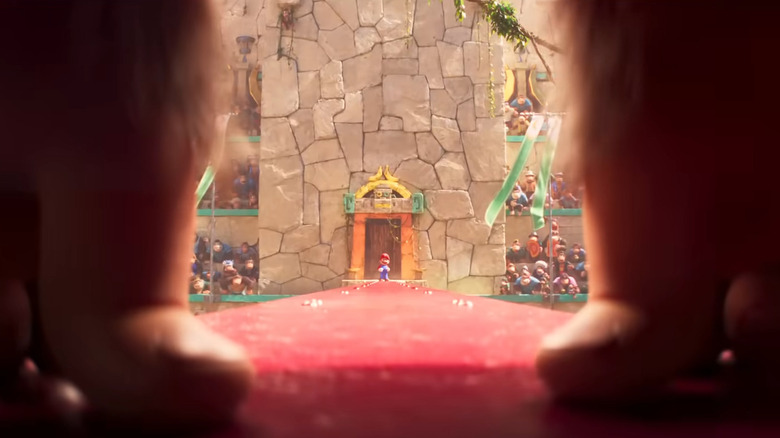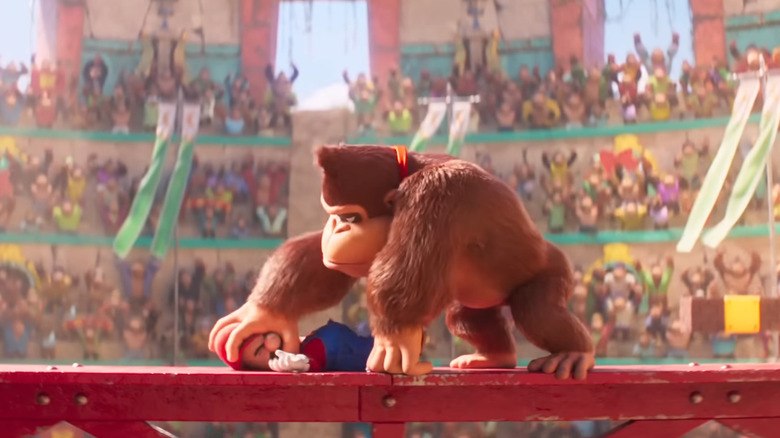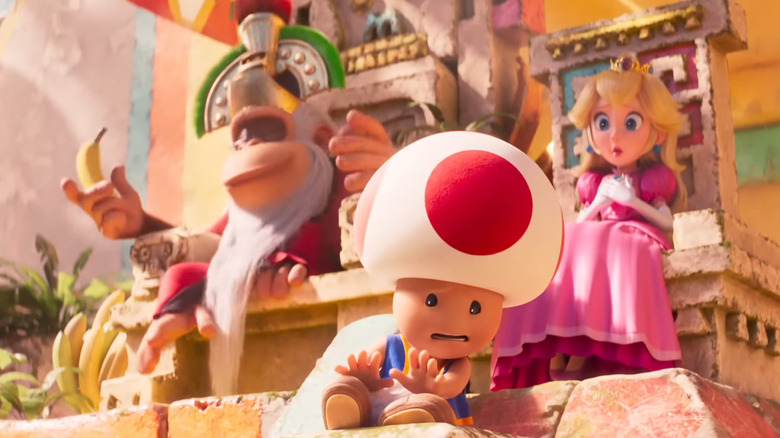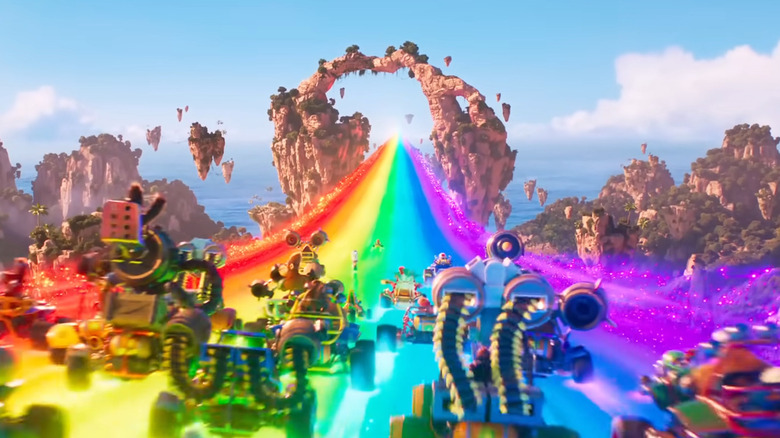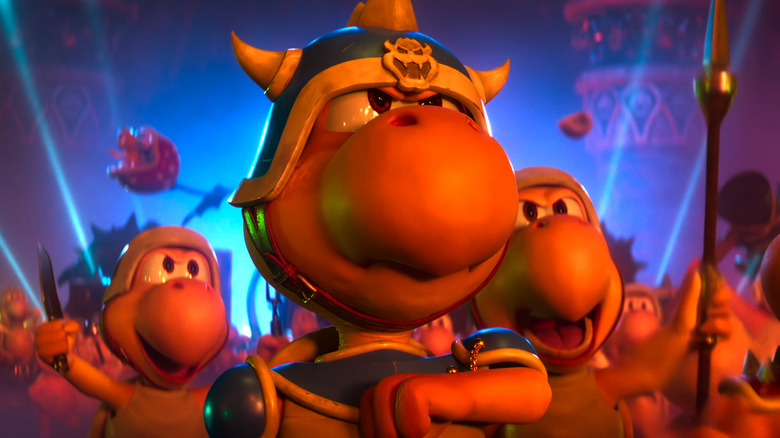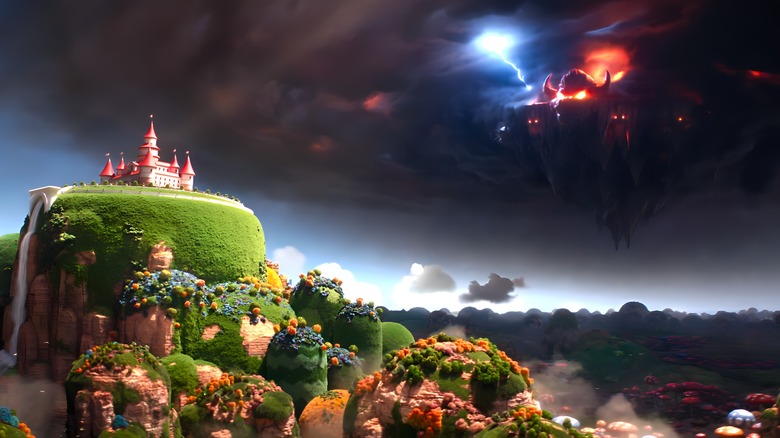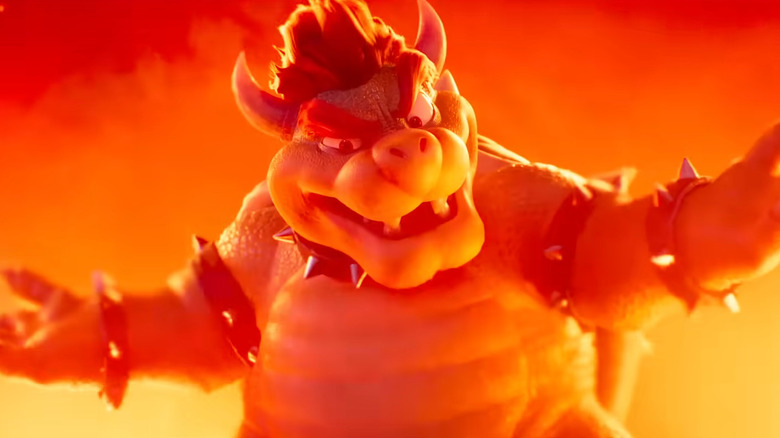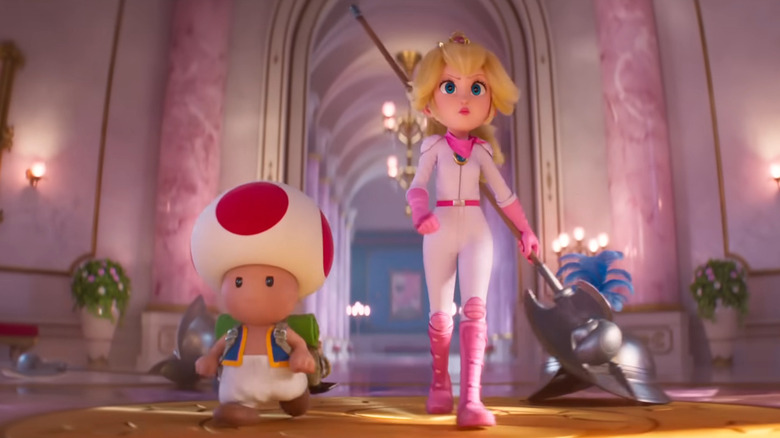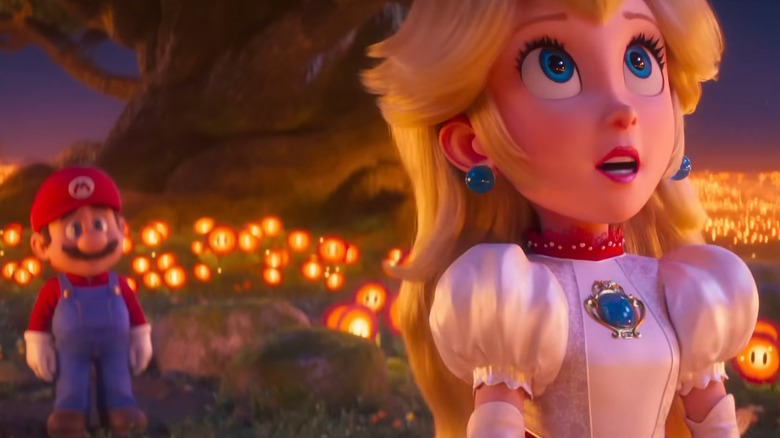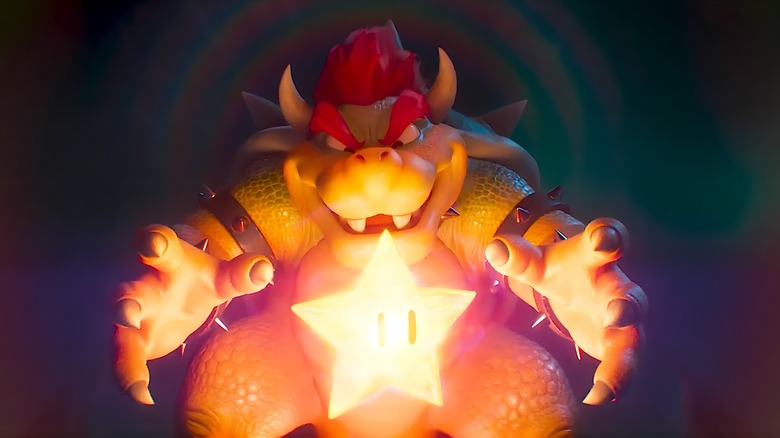Easter Eggs And References You Missed In The Super Mario Bros. Movie
Contains spoilers for "The Super Mario Bros. Movie."
"The Super Mario Bros. Movie" is finally here, and as you might expect, it's packed to bursting with Easter eggs. The animated film is Mario's second outing into the wide world of cinema, but it's a lot more faithful to the source material than his 1993 live-action debut. That's probably due in large part to Nintendo's heavy presence in production. Shigeru Miyamoto himself, the creator of the "Mario" franchise, served as a producer on the movie alongside Illumination's Chris Meledandri.
The result is a fun, breezy, and gorgeously animated 90-minute adventure flick with tons of patented "Mario" flair. There are Goombas. There are Koopas. There are Bullet Bills, Fire Flowers, and grand plans from Bowser to marry Princess Peach. Just about every major story beat and detail is ripped straight from the "Mario" games, and there are tons of smaller, less obvious references for diehard fans to watch out for. Here are the biggest Easter eggs in "The Super Mario Bros. Movie," along with some you may have missed.
Classic baddies
"The Super Mario Bros. Movie" opens with a brutal attack by Bowser's forces on the Ice Kingdom of the Penguins. The Penguins themselves are classic "Mario" characters, first appearing in the genre-defining "Super Mario 64," but it's Bowser's army of dangerous bad guys who steal the spotlight. All manner of Koopa Troopas are present — red-shelled and green-shelled variants, Paratroopas, ones with those spiky hats that make them oh-so-infuriating to land on, and many more. The Magikoopa known as Kamek leads the army, serving as Bowser's second-in-command.
Throughout the rest of the movie, a vast menagerie of classic "Mario" baddies parades across the screen. Luigi battles a horde of undead Dry Bones, who fall apart and reassemble with eerie clicks just like in the games. Bowser's prison guards patrol his lair in flying Koopa Clown Cars — King Koopa's own preferred method of travel in many of the games — which Cranky Kong references by telling them to keep their "clown claws" off of him later in the film. There are Hammer Bros. and Goomba stacks hidden in the background. There are leaping Cheep Cheeps, subaquatic Bloopers (who actually seem harmless here), and Bob-ombs.
There are so many familiar "Mario" enemies that even Bowser can't keep all their names straight. In one scene where he addresses his army, he calls out a group of Spinies — creatures thrown by the cloud-borne Lakitu in the original "Super Mario Bros." — and fails to remember what they're called. To be fair, they're pretty forgettable.
Super Mario Bros. Plumbing
Our introduction to the Mario Brothers comes in the form of a goofy commercial. Shot in the style of local small business ads, it shows Mario and Luigi wearing their iconic outfits and talking in over-the-top Italian American accents, which mirror their voices from the games. One moment shows them "flying" with yellow capes tied around their necks, referencing the ones used to fly in "Super Mario World" and deflect attacks in the "Super Smash Bros." series.
While never central to the mainline games, this background lore of the Mario Bros. as Brooklyn-based plumbers is a longstanding staple of the franchise. The first iteration of the Super Mario Bros. Plumbing company appeared on "The Super Mario Bros. Super Show!" Another iteration pops up in the 1993 "Super Mario" movie, in which the brothers drive a van similar to the one seen in the new movie. Of course, the animated van also features a graphic on the side of Mario leaping in cartoon form. This particular depiction of him evokes some of his more recent 2D outings, such as the "Paper Mario" games.
Even the Mario Brothers' status as down-on-their-luck plumbers can be seen as a reference to these past iterations. In both the "Super Show" and the 1993 live-action movie, Mario and Luigi grapple with tight company budgets and stiff competition.
The Punch-Out!! Pizzeria
After the Super Mario Bros. Plumbing commercial ends, we pull out to find the real Mario and Luigi hanging out in a local Brooklyn pizza bar. It's far from an ordinary establishment, however. The sign outside identifies it as Punch-Out Pizza, referencing the beloved Nintendo Entertainment System boxing game "Punch-Out!!"
This reference is more than just a simple name. Inside the restaurant, you can see framed pictures of many of the kooky fighters from the "Punch-Out!!" series, including first-rounder Glass Joe, tough guy Bald Bull, and lead protagonist Little Mac. Real-life boxing legend Mike Tyson, who served as the final boss of the original game, does not make an appearance.
"Punch-Out!!" isn't even the only game referenced in the pizzeria. There's also an arcade machine that plays what looks like a version of 1981's "Donkey Kong," Mario's first official game. However, the art on the side of the machine instead identifies it as "Jumpman." Some fans will recognize this as Mario's original name in his "Donkey Kong" days, before he was deemed worthy of a more personal moniker.
Quitting the Wrecking Crew
One of the deeper-cut references in "The Super Mario Bros. Movie" comes in the form of Spike, Mario and Luigi's former boss who torments them at Punch-Out Pizza but later applauds their efforts to save Brooklyn. Spike wears a hat with the words "Wrecking Crew" emblazoned upon it, which seems to be the name of his own construction (or rather, deconstruction) company. It might seem innocuous, but this is actually a clever callback to Mario's early days.
"Wrecking Crew" is a sub-series of the "Mario" franchise that began with an arcade game released in 1984 — just three years after "Donkey Kong" and one year after the original "Mario Bros." arcade game. Playing off of the success of "Donkey Kong," the game sets both Mario and Luigi on various action-packed construction site levels. In the NES version of "Wrecking Crew," the brothers must also contend with an antagonist named Foreman Spike, who's clearly the inspiration for the movie character.
This Easter egg works on multiple levels. It's a fun nod to the series' origins, but it also ties into the story. Spike is upset in the movie because Mario and Luigi quit his company to start their own. This can be read as a joke about how the "Mario" series became far more popular than the original "Wrecking Crew" game, or how (according to Miyamoto himself) Mario was a carpenter in "Donkey Kong" and only made a plumber once pipes were introduced. Regardless, Spike doesn't resemble his game counterpart much. His blue outfit actually makes him look more like Fix-It Felix from "Wreck-It Ralph," who himself was designed to evoke Mario.
It's-a Charles Martinet!
Many fans have expressed frustration with Chris Pratt's casting as Mario in "The Super Mario Bros. Movie." And there are still those who would prefer a different voice actor had been selected — specifically, Charles Martinet, who's played Mario, Luigi, Waluigi, and Wario in every major game since the early 1990s. While Martinet certainly doesn't have as big a role in the new movie as Pratt, he does offer his talents to two supporting characters.
A character credited as Giuseppe — seen playing "Jumpman" in the pizzeria at the start of the movie and briefly at the end — is voiced by Martinet. In this role, he gets to put his own incomparable spin on some classic Mario lines and sounds, capping off the movie with his iconic "Wahoo!" Martinet also voices Mario and Luigi's father. While this second character doesn't have as many recognizable Mario soundbites, it is clever and wholly appropriate casting, as Martinet has been the one responsible for bringing both characters to life for decades.
Treasures in Mario's bedroom
Mario's movie bedroom is a treasure trove of Nintendo Easter eggs. The most obvious one is the NES he has hooked up to his TV, on which we see him playing "Kid Icarus." Sadly, he dies pretty quickly in the game, conjuring the game's infamous "I'm finished!" game-over screen.
This is far from the only reference, though. On top of his TV, you can see a physical model of an Arwing, the ship flown by the main characters of the "Star Fox" games, also created by Shigeru Miyamoto. Numerous other retro Nintendo games are called out in the various posters that cover Mario's walls. One with the word "Falcon" printed on it features a picture of the Blue Falcon, a vehicle flown by Captain Falcon in the futuristic "F-Zero" racing games. Another poster that just says "Cool" has a picture of an upright polar bear wearing sunglasses, an enemy from the NES game "Ice Climber." Other NES games that the posters appear to reference include "Kung Fu" and "Spyhunter."
Given that Mario is the most famous Nintendo character, it only makes sense that his room is filled with references to the company's other games.
Mayor Pauline
Mario is pulled out of his bedroom by a TV news alert that shows rampant flooding in Brooklyn. On the broadcast, you can see a version of Mayor Pauline — a character with a rich history in the "Mario" franchise — attempting to calm the public while speaking to a reporter.
Pauline actually goes back as far as Mario himself, as it's her, not Princess Peach, who must be rescued in the original "Donkey Kong" arcade game. She also appears in the "Mario vs. Donkey Kong" games. In the Nintendo Switch hit "Super Mario Odyssey," Pauline enters the modern franchise timeline as the mayor of New Donk City, a Mario-fied version of the Big Apple.
In most of her incarnations, Pauline wears red and has dark hair. Her usual dress is swapped out for a striking red pantsuit while performing mayoral duties in "Odyssey," and it's this particular version of the character who's seen on TV in "The Super Mario Bros. Movie." The inspiration makes sense given her apparent movie role as yet another political leader in a major urban metropolis — this time, the actual NYC.
The old sewers
When Mario and Luigi try to help the flooding situation in Brooklyn, they wind up getting pulled down into a very deep and very old part of the New York sewers. It's there that they come upon the iconic green "warp pipe" that pulls them into the Mushroom Kingdom. This part of the sewers can be seen as an Easter egg in itself, as it evokes the setting of the original "Mario Bros." arcade game that succeeded "Donkey Kong." In the story of that game, Mario and Luigi are fixing problems in the NYC sewers when they're suddenly attacked by various monsters that emerge from green pipes.
The presence of "level" signs in the background of this scene makes it feel particularly like a reference. It would be an appropriate one too, since this is the place that begins their adventure, just as "Mario Bros." officially kicked off the "Mario" franchise.
Luigi's not-quite mansion
Anyone who's played a "Mario" game knows that Luigi is kind of a coward. Unfortunately, it's the defining personality trait that Nintendo has decided to stick him with through the years. Luigi's penchant for fear was eventually spun out into the "Luigi's Mansion" series of games, which gets its own little reference in "The Super Mario Bros. Movie."
When Luigi first arrives in the so-called "dark lands," he finds himself in a spooky forest haunted by Dry Bones. While there are no actual ghosts or mansions in sight — main staples of "Luigi's Mansion" — we do get a couple of direct nods to those games. Luigi's constant fidgeting with his flashlight is pulled straight from his sub-series, as is the quivering way he keeps calling his brother's name. It's a nice enough Easter egg, but it also would have been fun to get a bit more here. No Poltergust 3000? No "ghost house" level? No reference to Professor E. Gadd? Come on.
Welcome to the Mushroom Kingdom
The first few minutes after Mario arrives in the Mushroom Kingdom are downright packed with references and Easter eggs. In addition to Toad and the many giant mushrooms, the forested area Mario lands in has some more specific pulls from the games. He encounters multiple Biddybuds — bug-like critters known for traveling in groups — and a large Bramball sporting a recognizably dour expression. Both of these creatures are more recent additions to the Mario universe, debuting on the Nintendo 3DS and Wii respectively.
Once Mario and Toad get into town, things really start popping off. There are coin blocks that Toads use like ATM machines. There are moving platforms, power-up icons, and the clear warp pipes from "Super Mario 3D World." In one shot, you can see the marquee of a Crazy Cap store from "Super Mario Odyssey." In another, there's an "antique" shop filled with old-school items — P-switches, music boxes, and a pixelated hammer from "Super Mario Bros. 3," among others. One Toad is even shown carrying a Cheep Cheep in a plastic bag like a pet fish.
Of course, Peach's Castle is the crown jewel. The general look and layout of the palace stay true to the video games, and there are even some paintings of distant lands à la "Mario 64." Sadly, Mario doesn't try to jump through any of them, so it's hard to say for sure if they work.
The world map
One of the most iconic parts of the mainline "Super Mario" games is the world map. It takes different forms in different installments, but the idea stays the same — a visual representation of the various lands, kingdoms, or galaxies Mario must traverse. The world map is fun because it showcases the diversity of the different areas in each game. There's almost always an ice world, a desert world, a jungle world, a sky world, and so on.
In "The Super Mario Bros. Movie," we get multiple instances of the world map. One appears in Peach's throne room, composed of voxels — 3D pixels used in certain retro-aesthetic video games. Another, more traditional map of the same kingdoms appears later in Donkey Kong's house.
Even though the movie doesn't spend a ton of time in every one of these areas, we do get glimpses of most of them. Mario, Peach, and Toad journey through several in a single montage, visiting the floating inverted pyramids of a desert land, the foggy cliffs of a sky kingdom, a grassy world with a "Super Mario 64" cannon, and even Yoshi's Island (which, as you might expect, is filled with Yoshis). Of course, the true capital-Y Yoshi is saved for the film's post-credits scene, which shows a green egg cracking in the New York City sewers. That scene could be read as an homage to the ending of 1998's "Godzilla," though that might be a bit of a stretch.
New movie, old abilities
Sure, power-ups may be the main source of Mario's strength in the video games, but he and his allies also have some innate abilities that are always available to them. These are well represented in "The Super Mario Bros. Movie."
Princess Peach showcases some classic "Mario" moves while acing the training level she puts Mario through. These include wall-jumping, bouncing off of Bullet Bills to gain extra height, and floating gracefully to slow her aerial descent — a technique that is unique to Peach across many "Mario" games.
Later, while battling Bowser's minions with Donkey Kong during the film's climax, Mario executes a flawless ground-pound, more colloquially known as a butt stomp. He also has a couple of classic platforming sequences, such as when he's running to Bowser and Peach's wedding with Donkey Kong and when he's navigating the construction site at the beginning of the story. It's these little touches that show the attention to detail that went into "The Super Mario Bros. Movie," and the whole film is a lot more fun for fans to watch because it includes them.
A lot of (Mario) galaxies
There are so many beloved "Super Mario" games that putting some above others can feel ridiculous. However, the "Super Mario Galaxy" games are definitely in the upper echelon, and "The Super Mario Bros. Movie" seems to agree.
There are numerous references to the Wii games throughout the film. The most obvious is Lumalee, the unsettlingly cheerful-yet-nihilistic character seen in Bowser's dungeon. In the "Mario Galaxy" games, Lumas are a star-shaped race of friendly cuties who aid Mario on his journey. Lumalee is the name used for a specific variety of Luma in the games who sell Mario items in exchange for "star bits," a kind of currency. The character's name comes from their friendly jingle, "Lumalee, Lumabop, welcome to the Luma Shop!"
The way in which Mario pays is a bit strange, however, as he must fire the star bits directly into Lumalee's mouth, causing the star being to transform into the item being purchased. Lumalee's bizarre acceptance of death in the movie could be a nod to this dynamic. The character's light blue coloring is also the same as in the games.
Lumalee isn't the only "Galaxy" reference. When Mario and Luigi are trying to fix a sink near the beginning of the movie, one of their rich clients can be seen reading a book entitled "Galaxy," which has a picture of one of the games' tiny planets on it. Later, Peach appears to make her own allusion by telling Mario, "There's a huge universe out there with a lot of galaxies." Unfortunately, Princess Rosalina doesn't make an appearance, but maybe in the sequel!
Not every Toad is the same
There are a lot of Toads in the Mushroom Kingdom, but some stand out more than others. "The Super Mario Bros. Movie" features all the different colors of Toad that fans will be familiar with from the games, as well as a couple who have a bit more main-character energy.
Unsurprisingly, the first of these is the main Toad voiced by Keegan-Michael Key. Though he's only ever referred to as "Toad" in the film, he has the huge backpack of the video games' Captain Toad. First appearing in the "Super Mario Galaxy" games, Captain Toad has since become a staple and the primary Toad of the franchise. He even got his own standalone game. Perhaps if there's another "Mario" movie down the line, the first film's Toad could officially be granted the rank of captain.
The other notable Toad in "The Super Mario Bros. Movie" is the bespectacled advisor to Princess Peach. This character would seem to be a stand-in for Toadsworth, the elderly butler Toad who acts as Peach's aide in many of the games. However, the look of the movie character is all wrong. Aside from the glasses and general Toad shape, the two have nothing in common. Where Toadsworth has brown spots, a beard, and a walking stick, the character in the movie is a purplish blue and seems much younger. His look is much more similar to that of Hint Toad from the modern games, and both characters likely served as inspiration.
Familiar tunes
In classic Illumination fashion, "The Super Mario Bros. Movie" is filled with licensed pop songs, from "Holding Out for a Hero" to "Take On Me." As is usually the case with such selections in animated family movies, they range from mildly endearing to full-on cringe. Fortunately, the "Mario" movie is also loaded with new renditions of Koji Kondo's original scores from the games.
There are tunes from the original "Super Mario Bros." right up to "Super Mario Odyssey," with tons pulled from the games in between. Some are used in more general ways, like turning classic jingles into royal fanfares at Peach's Castle, but others are sprinkled in subtly and specifically, creating fun musical Easter eggs to keep your ears tuned for. When Mario and Luigi first go underground in the New York sewers, we hear the haunting notes of the "Underground Theme." When they journey into the Kongs' massive kart garage, there's "Mario Kart" music. There's the "Underwater Theme" for the underwater bits, a little "Mario Galaxy" music thrown in toward the end, and tons of other little refrains sure to tug on your nostalgia.
But they're only babies!
To drive home just how protective Mario has always been of his little brother, we get a cute flashback scene of Luigi building a castle (appropriate) with blocks as a little tyke. When a bully comes over and smashes it, Mario leaps in to fight him off and cheer up his bro. It's a cute moment that also lets the movie pull in the Baby Mario and Baby Luigi designs from the games.
Though they're technically just younger versions of the brothers, Baby Mario and Baby Luigi have practically become independent characters in their own right. They've starred in their own games like "Yoshi's Island" and co-starred with their older selves in 2005's "Mario & Luigi: Partners in Time." In the "Mario Kart" franchise and some "Mario" sports games, the babies are separate selectable characters.
The movie also gives us a brief look at Baby Peach and her mysterious arrival in the Mushroom Kingdom. Like Baby Mario and Baby Luigi, Baby Peach is an independent character in several games.
Bowser's musical mayhem
One of the more curious additions to Bowser's character in "The Super Mario Bros. Movie" is his penchant for musical performance. On two separate occasions, we see old King Koopa tickling the ivories and belting out a love ballad for Princess Peach. While not exactly an Easter egg, this seems like a clear nod to Jack Black's long career as a musician. The comedian is perhaps most famous for musical films like "School of Rock" and his work in the comedy band "Tenacious D," so it makes sense to also give him a song or two as Bowser.
There's a more specific "Mario" Easter egg in these scenes, however. The beautiful grand piano Bowser plays on has "Ludwig von Koopa" inscribed on it. In the games, Ludwig von Koopa is the oldest member of the Koopalings: a group of elite Koopas who serve under Bowser as minibosses. His name and design have always been references to legendary musician Ludwig van Beethoven, so calling him out in this particular way makes a lot of sense.
Power up!
What would a "Super Mario" movie be without power-ups? Fortunately, we don't have to know, as the new film is full of them. Multiple characters, including Peach and Donkey Kong, use Fire Flowers. Peach uses an Ice Flower to freeze Bowser in the final battle. Mario's first power-up, of course, is a regular Super Mushroom — ironic given his distaste for them in the movie. As in the games, the mushroom makes him bigger and stronger. The first thing he does after eating one is break a brick block, which is a nice touch because those blocks are only breakable in the games when you're Super Mario.
In his battle with Donkey Kong, Mario becomes Cat Mario, a newer power-up from the games. Like in "Super Mario 3D World," Cat Mario has better reflexes, sharp claws, and a powerful divebomb attack, which he uses to finish off DK. For the final battle, Mario gets his famous Tanooki Suit upgrade from "Super Mario Bros. 3," which allows him to fly and use a tail-whip attack. Different characters refer to him as both a raccoon and a bear in this form, which is a subtle nod to the power-up's origins. Inspired by the Japanese raccoon dog, the Tanooki Suit is a slight upgrade over the regular raccoon suit in the games. A version of the blue Mini Mushroom also appears at a few key points in the movie.
Mario vs. Donkey Kong
Though Bowser is the main villain of "The Super Mario Bros. Movie," we do get a decent bit of the even older rivalry between Mario and Donkey Kong. Mario battles DK to win the Kong army over to Peach's side, and their duel takes place in an arena that looks pretty familiar. There are red girders everywhere, evoking the ones that make up the stages in the original "Donkey Kong." and of course, DK throws a bunch of barrels at Mario during the fight, paying tribute to his arcade game heritage.
There are some deeper cuts here, too. In the game lore, Cranky Kong is canonically the Donkey Kong from the original "Donkey Kong" game. His son in that timeline is Donkey Kong Jr. — the star of the lesser-known sequel of the same name. The Donkey Kong who modern fans know and love is technically Cranky's grandson, but the movie smartly simplifies this genealogy by making the main DK Cranky's son instead. Regardless, it's fitting for Cranky to be present at the fight, given that he was the first one to ever face off against Mario in the games.
Super Smash Bros. moves
While he's most famous for his own games, Mario has become similarly well-known for his appearances in the popular "Super Smash Bros." series. Appropriately, some recognizable moves from those games also make their way into "The Super Mario Bros. Movie."
Mario uses a swinging jump punch move multiple times, most notably in his training montage against a cardboard cutout of Bowser. This move has been part of his "Smash" kit for decades in the form of his forward-aerial attack. Donkey Kong also uses some of his own "Smash" attacks in his fight with Mario, including his down-special (which sees him repeatedly slapping opponents on the ground beneath him) and his forward-smash attack, which takes the form of a giant clap. Mario also uses his patented Super Jump Punch and DK his "giant punch" at different points, though these two moves have more original grounding in the characters' respective franchises.
The other members of the DK Crew
Cranky Kong and Donkey Kong are the main Kongs in "The Super Mario Bros. Movie," but they aren't the only ones. During DK's duel with Mario, you can see a number of other characters from the "Donkey Kong" games cheering their pal on. Diddy Kong, Dixie Kong, and Chunky Kong are all sitting next to each other for the event, and Diddy even gets called out by name at one point. Later, Funky Kong can be seen driving a kart behind Mario on Rainbow Road. There's no mistaking those sunglasses.
Donkey Kong's first appearance is also set to the DK Rap, which his fans in the crowd appear to be singing. The goofy tune first appeared in "Donkey Kong 64," and a more upbeat version plays on the "Super Smash Bros. Melee" stage "Kongo Jungle."
The whole Jungle Kingdom area in the movie pulls heavily from the "Donkey Kong Country" games. The Kongs' seaside huts, adorned with hammocks and packed with bananas, appear in numerous entries in the series.
Choose your kart!
"Mario Kart" might be the most popular sub-series of "Mario" games, so it only makes sense for it to play a major role in the movie. In order to tie the concept of super-powered go-karts into the rest of the story, the film makes the karts central to Kong society, which works pretty well. Mario, Peach, and Toad get to design their own karts in the Kongs' massive garage, which is filled with specific nods to the games.
In addition to the music, the characters build their karts using three slider wheels to select a base, wheels, and glider. This is exactly how you construct a kart in the most recent "Mario Kart" games. Mario's ride is a slight variation on his classic red kart from the games, and Peach dons her biker suit from the series to ride a matching pink motorcycle — first introduced in "Mario Kart Wii."
The race scenes also pull in lots of maneuvers from "Mario Kart," such as hopping into drifts, glider sections, and zero-gravity segments that utilize hover wheels. Mario does a track-skip shortcut at one point, proving his prowess as a competitive gamer. Characters attack each other with banana peels, green shells, and the deadly homing blue shell. And of course, the entire Koopa chase sequence takes place on Rainbow Road, the most famous track from the games that appears in every installment.
Why is there boss music?
In addition to the more regular baddies like Koopas and Goombas, "The Super Mario Bros. Movie" features some bigger foes from the franchise. After getting blown off of Rainbow Road, Mario and Donkey Kong land in the water and are devoured by a giant red eel, known as a Maw-Ray in the games. The massive creatures first appeared in "Super Mario 64" and have been a staple ever since.
Near the end of the film, Bowser launches a "Bomber Bill" to destroy the Mushroom Kingdom, which Mario cleverly thwarts. Also known as "Banzai Bills" in the games, these giant Bullet Bills first popped up and started tormenting Mario in "Super Mario World." Their huge size makes them more common in the series' 2D outings, where you can't dodge them by simply moving to the side. The Bomber Bill in the film appears to be an upgraded version, as it homes in on Mario with frightening accuracy.
Say the line!
The "Mario" franchise isn't exactly known for its dialogue, but the movie still manages to fit in a bunch of iconic lines. The red plumber himself lets fly with plenty of instances of "Wahoo," "Mama mia," and "It's-a me," as do the characters voiced by Charles Martinet. "Let's-a go" and "Here we go" can also be heard, the latter spoken by Peach instead of Mario this time around.
Then there are the meme lines. When Mario first tries to enter Princess Peach's castle to talk to her, the Toad guards refuse to let him in. "Our princess is in another castle," they say sarcastically, echoing the infamous line from the original "Super Mario Bros." And of course, for some inexplicable reason, Donkey Kong himself insists during his fight with Mario that it is "on like Donkey Kong" — an adage that's never spoken in the games but has nonetheless become immediately recognizable slang. Honestly, that last one is a bit much.
Nintendo's (other) greatest hits
Mario's bedroom decorations aren't the only references to other Nintendo games in "The Super Mario Bros. Movie." The film's version of Brooklyn is loaded with retro Easter eggs, including a car wash with the "Balloon Fight" kid on the sign, a travel agency referencing "Super Mario Sunshine," and a truck with original Nintendo star Mr. Game & Watch on the side.
There are also a few different references to "Duck Hunt" in the movie. One restaurant glimpsed in the background of the Brooklyn scenes is called "Chasse au Canard," which roughly translates from French as "Duck Hunting." Then there's the temperamental dog named Francis who attacks Mario and Luigi early in the movie. While clearly a different breed, Francis is the same color as the similarly infuriating "Duck Hunt" dog and could be meant as a reference. Alternatively, Francis could be an allusion to Shigeru Miyamoto's infamous encounter with an angry, chained-up dog, which gave him the idea for Mario's Chain Chomp enemy.
Console-ation prizes
Games aren't the only Nintendo products referenced in "The Super Mario Bros. Movie." There are also a number of Easter eggs tied to the company's various game systems. During the Mario vs. Donkey Kong battle, one Kong can be seen wearing a "64" t-shirt in the crowd — a nod to the Nintendo 64. When Luigi's green cellphone starts to ring, fans may recognize the ringtone as a variant of the GameCube startup jingle.
One of the more bizarre references is a store called Disk-Kun, whose sign bears a cute floppy disk-shaped character. This is a nod to Diskun, the mascot of Nintendo's Famicom Disk System console. Of course, the biggest console Easter egg in the movie is Mario's original Nintendo Entertainment System, on which he plays "Kid Icarus." The blocky grey box and controllers are faithfully recreated, but it's a little sad to know he can't play "Super Mario Bros." on the system.
Distinguished wedding guests
"The Super Mario Bros. movie" takes a lot of story beats from "Super Mario Odyssey," including Bowser's plan to make Princess Peach marry him. For the wedding, he wears the same flashy white tuxedo and top hat combo seen in that game, and he also offers her the same terrifying bouquet made of tiny Piranha Plants.
If you peek into the pews just before the wedding begins, you might notice a few distinguished guests. King Bob-omb, the first boss in "Mario 64" and a later staple of the "Mario Party" series, is seen advancing up the aisle to a seat near the front, his luscious mustache billowing. When he sits down, he accidentally bumps a green Koopa shell and causes it to bounce back and forth between him and the side of the bench. This references both the perpetual motion of green shells and King Bob-omb's own relative invincibility to normal "Mario" attacks.
Also present are King Boo (wearing his own shiny crown) and a Sledge Bro, a hulking Hammer Bro variant from the games. Clearly, Bowser invited all of his closest friends.
Superstar showdown
"The Super Mario Bros. Movie" ends with a climactic battle: Mario and Luigi vs. Bowser. Now back in Brooklyn after some warp pipe shenanigans, the two brothers embrace the superstar to unlock immense power. Just as in the games, they become invincible after touching the star, allowing them to defeat King Koopa and his lackeys with ease. The star music plays in the background, and they even do the arms-out run you can perform in the games with the star power-up's extra speed.
Not everything about this final scene is quite accurate to the source material, however. If you've played the games, you'll know that a star's invincibility makes it impossible to bounce off of enemies, as they simply crumble at your touch. Mario and Luigi are still able to jump off of some Bullet Bills in the climax battle, so maybe they know something we don't about how to harness the star's true power.

